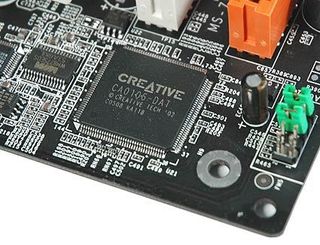Budget And Premium Motherboards At The Crossroads
Audio Features

A fully-featured Creative audio chip is used rather than Intel's audio device - although this one is a High Definition Audio part as well.
Audio chips have lost much of their impact for the average user over the years. Back in the 90's it was necessary to install a sound card (Soundblaster or compatible) to have audio capabilities, but the introduction of the AC97 standard moved audio into the chipset. All core logic products are able to process above CD-quality multi-channel audio today, and high-class motherboards feature additional digital audio inputs or outputs.
Some premium motherboards implement dedicated sound chips that raise the quality bar up to stellar frequency resolutions (96 kHz) at up to 24 bits, with multi-channel operation. In addition, they help to reduce CPU load by offloading all required processing to the audio chip.
Additional Interfaces
Another item that is worth discussing is the number of additional interface ports that can be used for connecting multimedia or communication devices. USB 2.0 certainly is the most common interface for external devices. Today you can find keyboards, mice, printers, webcams, storage devices, scanners, headsets and many other devices using the USB interface. Most motherboards are capable of handling either eight or ten USB 2.0 ports, but only four or six can usually be used immediately. The extra ports need to be enabled by using a slot adapter module that connects to USB 2.0 interfaces on the motherboard.
The second popular external interface is IEEE-1394, aka Firewire. Two standards are around: IEEE 1394a runs at up to 400 Mbit/s, while Firewire 1394b supports 800 Mbit/s data transfers. In contrast to USB 2.0, Firewire runs an isochronous protocol and allows for real-time data transfers. This is particularly interesting for streaming applications and digital video. Firewire devices usually are daisy-chained, which means that one or two ports will generally be enough.
Software Features
The software factor is another issue worthy of consideration when choosing a motherboard. The term "software" encompasses not only what the motherboard companies usually bundle with their products, but also includes things like the feature set of the BIOS, overclocking and monitoring utilities, and auto-overclocking options.
To get more control over technical parameters, you will want more BIOS entries at your disposal. Enthusiast motherboards come with multiple options to alter clock speeds and voltages, memory timings, bus parameters, and more. However, if you do not care about fine-tuning or overclocking, you will likely never need any of these.
Stay on the Cutting Edge
Join the experts who read Tom's Hardware for the inside track on enthusiast PC tech news — and have for over 25 years. We'll send breaking news and in-depth reviews of CPUs, GPUs, AI, maker hardware and more straight to your inbox.
Current page: Audio Features
Prev Page Mass Storage Controllers Next Page Making The Budget Choice: 915PL Neo-VMost Popular

